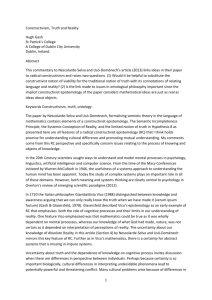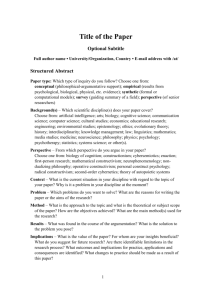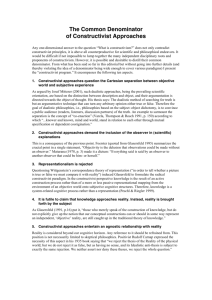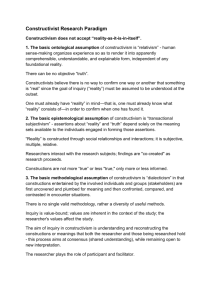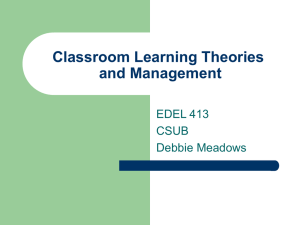Key contributors: Ernst von Glasersfeld's radical constructivism
advertisement
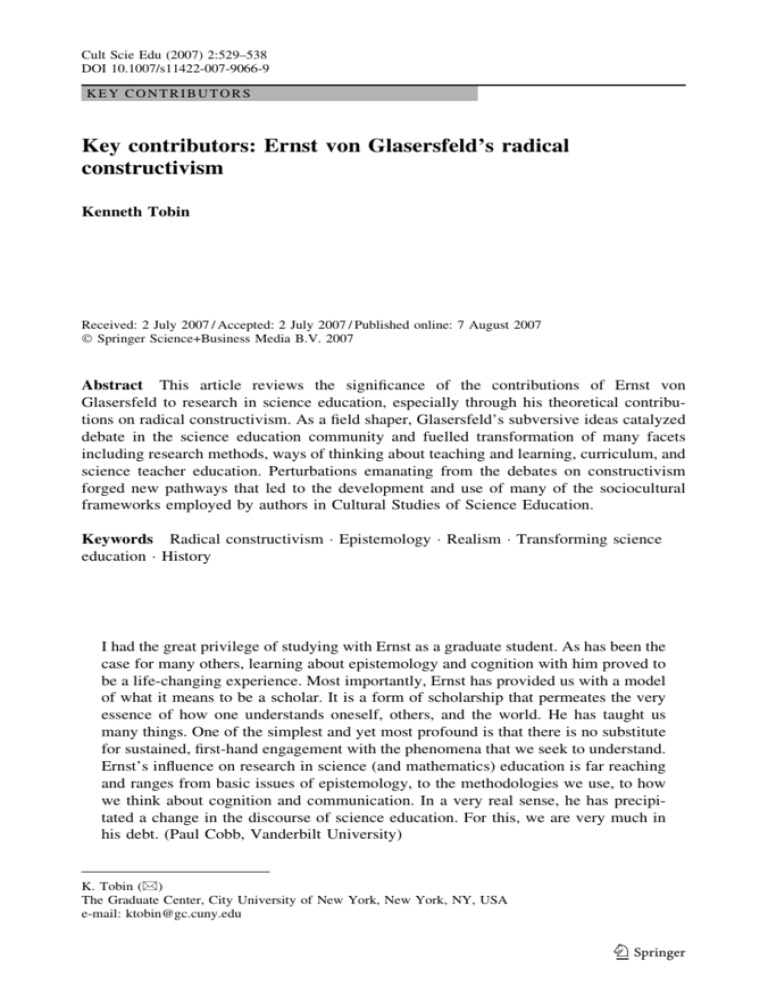
Cult Scie Edu (2007) 2:529–538 DOI 10.1007/s11422-007-9066-9 KEY CONTRIBUTORS Key contributors: Ernst von Glasersfeld’s radical constructivism Kenneth Tobin Received: 2 July 2007 / Accepted: 2 July 2007 / Published online: 7 August 2007 Ó Springer Science+Business Media B.V. 2007 Abstract This article reviews the significance of the contributions of Ernst von Glasersfeld to research in science education, especially through his theoretical contributions on radical constructivism. As a field shaper, Glasersfeld’s subversive ideas catalyzed debate in the science education community and fuelled transformation of many facets including research methods, ways of thinking about teaching and learning, curriculum, and science teacher education. Perturbations emanating from the debates on constructivism forged new pathways that led to the development and use of many of the sociocultural frameworks employed by authors in Cultural Studies of Science Education. Keywords Radical constructivism Epistemology Realism Transforming science education History I had the great privilege of studying with Ernst as a graduate student. As has been the case for many others, learning about epistemology and cognition with him proved to be a life-changing experience. Most importantly, Ernst has provided us with a model of what it means to be a scholar. It is a form of scholarship that permeates the very essence of how one understands oneself, others, and the world. He has taught us many things. One of the simplest and yet most profound is that there is no substitute for sustained, first-hand engagement with the phenomena that we seek to understand. Ernst’s influence on research in science (and mathematics) education is far reaching and ranges from basic issues of epistemology, to the methodologies we use, to how we think about cognition and communication. In a very real sense, he has precipitated a change in the discourse of science education. For this, we are very much in his debt. (Paul Cobb, Vanderbilt University) K. Tobin (&) The Graduate Center, City University of New York, New York, NY, USA e-mail: ktobin@gc.cuny.edu 123 530 K. Tobin In the year in which Ernst von Glasersfeld celebrates his 90th birthday it is fitting to explore his extensive work and its impact on science education. Though he would not regard himself as a science educator, his scholarship has shaped the field profoundly. Within science education there are just a few scholars that have shaped the field to the same extent and in ways that warrant their work being cited for years after its initial publication. John Dewey, Jean Piaget, and Lev Vygotsky are three field shapers. Based on my experience with science education, Glasersfeld is another. James Gallagher, who recently retired from Michigan State University and is a recipient of the Distinguished Contributions to Research Award from the National Association for Research in Science Teaching, seems to agree. He noted that: I met him once, and listened intently to what he had to say. Since I had been ‘‘raised’’ in the logical positivist tradition in science, it was an ‘‘eye-opener’’ to learn about his perspective on science knowledge. Although his ideas were extreme, they influenced my thinking about the nature of science and about learning with understanding. I would place him among the creative minds of our time. I am so pleased to have had the opportunity to interact with him. Whereas Glasersfeld is not the only theoretician to employ the term constructivism, his scholarship set the stage for many scholars to reflect on what they were doing and, often to make changes. More than 3,000 publications using the keywords constructivism or constructivist have appeared in high-impact journals from the mid-1970s to the present. The first reference to constructivism in the database is in 1967, increasing to twelve sources by 1976. From 1993 onwards the trajectory increased to more than 100 sources a year and then, since 1999, more than 200 sources a year refer to constructivism. Of course this is the tip of an iceberg since the vast majority of the literature is not included in the Web of Science database and many articles probably address constructivism without including the term either in the title, abstract or keywords. As a test of this iceberg hypothesis I entered constructivism or constructivist into a Google search and obtained 711,000 hits and when I entered Glasersfeld, there were almost 150,000 hits. Glasersfeld has a homepage at http:// www.vonglasersfeld.com/ Here insights are provided on the turbulence of his life in war torn Europe, his pathways into scholarship, and his extensive contributions to many fields, including cybernetics and education. When I became a science teacher in 1964, Glasersfeld was involved as principal investigator on a language research project in Milan, Italy. By the late 1960s his project had relocated to Athens, Georgia and Glasersfeld joined the University of Georgia in 1970, eventually working his way through the ranks to full professor in the Department of Psychology. By the time I arrived at Georgia to do my doctorate, in 1978, Glasersfeld had already commenced his research with Les Steffe in mathematics education. Steffe, over many years Glasersfeld’s most serious collaborator, wrote as follows. I attended a colloquium given by Ernst von Glasersfeld at the University of Georgia circa 1974. In the colloquium, Ernst recounted a story published by Lettvin et al. (1959) that at once established a bond between the two of us that has lasted from then on up through the present time. When talking about a frog as a fly-catcher, he commented that: The system [the frog’s visual system] as a whole makes the frog an efficient fly-catcher, because it is tuned for small dark ‘‘objects’’ that move about in an abrupt fly-like way. In the frog’s natural habitat, as we, who observe the frog see it, every item that possesses the characteristics necessary to trigger the frog’s detectors in the 123 Key contributors 531 proper sequence is a fly or bug or other morsel of food for the frog. But if the frog is presented with a black bead, an air-gun pellet, or any other small dark moving item, it will snap it up as though it were a fly. In fact, to the normal frog’s visual apparatus, anything that triggers the detectors in the right way, is a ‘‘fly’’. (Glasersfeld, 1974, reprinted in Glasersfeld, 1987, pp. 106–107) The frog story, which is a result of biological research, immediately resonated with me because it clarified my attempts at building models of the mathematical minds of the students that I taught and why Born (1968) said, ‘‘Thus it dawned upon me that everything is subjective, everything without exception. That was a shock’’ (p. 162). Following on from the subjectivity of experience, Ernst’s model of knowing is often criticized as being only psychological in nature and restricted to the individual. But I have always wondered if his critics have considered his philosophy of language (Glasersfeld, 1987), his view of communication (Glasersfeld, 1995), and the fact that he is fluent in four languages. Working with him in one language has been an extraordinary experience, and I am left with only imagining what it would have been like to work with him in four languages. Clearly, Glasersfeld’s impact in mathematics was not confined to Georgia. Martin Simon, a leading mathematics educator from New York University, emphasized the groundbreaking nature of Glasersfeld’s contributions to the field of mathematics education. Ernst’s contribution to mathematics education is unparalleled. By importing and interpreting Piaget’s ideas and by establishing a constructivist theoretical basis for mathematics education, Ernst provided the foundation for much of the most important mathematics education research of the last 30 years. Impact in science education I first heard the term constructivism, used during a heated conversation I had with some fellow doctoral students from the mathematics education program at the University of Georgia. The science and mathematics education programs were in the same building, but they were as unalike as could be imagined—even though each was arguably the top ranked program in its field in the United States. Whereas the science education program was strongly behaviorist, the mathematics education program focused on learners constructing meaning and pioneered methods to explore learning in ways that reflected emerging constructivist orientations. To be sure there were differences within the mathematics education group, but there was an upwelling of enthusiasm for all that constructivism brought to the table and, faculty members like Les Steffe, were energetic and effusive about the constructivist perspective. In contrast, my classroom-oriented research employed standard methods of positivism and incorporated multivariate analyses of complex data sets. However, I was searching for improved ways to theorize teaching, learning to teach, and learning. Also, I was acutely aware of the reductionist nature of my research and frustrated at its inability to be responsive to what I experienced when I visited classes and to explore macrostructures such as the impacts of high stakes testing. At the University of Georgia graduate student networks encouraged more science education students to take courses with Glasersfeld and, as Russell Yeany tells it, when they returned to science education from Glasersfeld’s classes they were different, questioning the status quo and seemingly empowered with respect to what they were to learn 123 532 K. Tobin and how they were to learn it. These signs of change in science education at the University of Georgia were an indication of more pervasive nature that were not confined to the United States. The adoption of constructivism in education was to be global in extent. During the 1980s, Mariona Espinet, now a leading science educator from Universitat Autònoma de Barcelona, in Spain, took graduate classes with Glasersfeld at the University of Georgia. She especially valued his European style of scholarship. In a discussion of Glasersfeld, the teacher, she noted that: Ernst was different...yes we are all different...but he was especially different...Open, challenging, encouraging, tremendously respectful to learners, superb manners that reflected his central European education. Above all, he was a struggler, a survivor in the academic world of the eighties in the USA. Ernst was one of those pearls shining across in a Southern campus. I wondered, ‘‘What is this professor doing here? How could he have chosen this place, in the South of USA, to cultivate his radical viewpoint?’’ He was not easily seen, but once you met him, once you had established communication, as a doctoral student, it was impossible to forget him. I had the feeling that he saw himself as a minority within the academic world. He introduced me into an invisible college that supported a different view on academia. Little by little I learned that some academics needed different thinking styles that were not cultivated or appreciated enough by the established academic world and needed parallel structures to support them! My meetings with him were excellent sources of good ideas, of identity construction, and of understanding radical constructivism. Ernst taught us how to see constructivism from a more philosophical viewpoint; feeding the concept with new challenges! I came to the USA after having spent one year in a research institution in Barcelona, Spain, that used the Piagetian works to develop an operational pedagogy. Piaget mainly influenced my view of constructivism. Ernst was committed to constructivism, and was not just an updated psychologist. He was faithful to his theoretical nucleus and spent his academic life developing the basis for radical constructivism. He inserted a philosophical strand into the debate on constructivism that was just starting in science education in the late seventies. His way of being a scholar was very European in that theory is not something easily changed, but is instead a commitment that might last a full academic life. Ernst was one of the leaders and I was grateful to learn from him. During the latter part of the 1980s Glasersfeld began to make a mark in science education. Three keynote addresses at international science education meetings created major perturbations and sowed the seeds for the field to transform. The first of these, in 1989, was delivered at the first meeting of the History and Philosophy of Science and Science Teaching group in Tallahassee, Florida. His other keynote addresses were to the American Association for the Advancement of Science and the National Association for Research in Science Teaching in the 1990s. As one of the organizers of all three events, I was startled to experience a small amount of high-energy dissension to radical constructivism among philosophers and scientists. There appeared to be a base need for science to retain its position as the ultimate voice, a discourse that produced truths or knowledge claims that over time iterated toward the truth. Following the conference several of the philosophers of education launched attacks on constructivism in books and journals—often misrepresenting Glasersfeld’s claims and rarely taking the time to check with him on the viability of how they represented his perspectives. I found the attacks to be polarizing and not useful. Whereas Glasersfeld collaborated with Steffe and others in research on learning and 123 Key contributors 533 teaching, especially in mathematics, his opponents ‘‘tore planks from the boat’’ and rarely offered alternatives. Among those who clung to realist views about knowledge and knowing is William Cobern, a professor from Western Michigan University. Cobern, who does not fully embrace the tenets of constructivism, commented that: Like many people in the science education research community, it was Ken Tobin who introduced me to the work of Ernst von Glasersfeld. It was 1988 or 1989 and I read every Glasersfeld paper I could get. Several came straight from him as he graciously responded to my requests. I was then (and remain today) a staunch realist so I knew from the start that I was unlikely to convert to radical constructivism, not that I wasn’t tempted. Glasersfeld reminded me of Thomas Kuhn. Here was someone else who not only had a powerful idea but one who could also express ideas in an accessible and winsome manner. By contrast, philosophy can be an esoteric, arcane discipline with little apparent practical value for educators. Not Glasersfeld’s ideas. When he addressed the 1990 annual NARST meeting the response was so enthusiastic later some likened the plenary session to an evangelical tent meeting; ‘‘is constructivism the new religion in science education?’’ Also like Thomas Kuhn, Glasersfeld’s ideas were timely. Misconception and conceptual change research were emerging in the science education research community. Glasersfeld’s constructivism provided a very effective metaphor for how learning takes place that neatly fit with misconception and conceptual change research providing a much needed theoretical basis in cognition, with the added appeal of being related to both Kuhn and Piaget. Of course, Glasersfeld’s real interest was the epistemology of ‘‘radical’’ constructivism, not learning theory, which he referred to as ‘‘trivial’’ constructivism. Like Kuhn’s sociology of scientific knowledge, radical constructivism became an important link in the line of descent leading to multicultural relativism in science education. Powerful ideas, however, tend to take on lives of their own regardless of their progenitor’s original intent, and sometimes to the progenitor’s chagrin. I hope Ernst von Glasersfeld is not too disappointed, but I think the real debt we owe to him is for ‘‘trivial’’ constructivism, not ‘‘radical’’ constructivism. Young researchers and doctoral students today may not know his name any more, but anyone of them doing learning research in science education is working in his shadow. I hope he is pleased. Perhaps typical of the conceptual change researchers who were influenced by Glasersfeld’s constructivism is David Treagust, also a recent recipient of the Distinguished Contributions to Research Award from the National Association for Research in Science Teaching. Treagust noted that: My doctoral research at the University of Iowa involved an investigation of students’ knowledge construction in terms of Piagetian infralogical groupings. This research followed a series of seminars conducted by Professor Darryl Phillips for which we read many of Piaget’s books. These readings and my research gave me an understanding of students’ knowledge construction based on Piaget but without a broader context. Ernst’s writings on constructivism, which I first read in the early 1980s, provided me with a much deeper appreciation of this notion and its relation to what pedagogy might be conducted in the classroom and his theoretical contributions have been very beneficial for my research agenda over more than two decades. Perhaps I am biased because I found Glasersfeld’s contributions to be thoughtful and extremely subversive. My impression is that the center of mass in science education shifted 123 534 K. Tobin and Glasersfeld’s work catalyzed more explicit attention to theory. For example, John Staver, who is my vintage within the science education field, had applied some of Piaget’s ideas in his research. It is clear from his remarks that Glasersfeld’s speaking and writing significantly impacted Staver’s scholarship. When I think of Ernst von Glasersfeld, I focus immediately on the root paradox. Among all of the concepts of radical constructivist epistemology, the root paradox stands front and center for me. This ancient paradox tells me that humans have but one connection—experience—with reality, the world that is external to, separate from, and independent of our consciousness. In order to establish that any knowledge claim represents or corresponds to reality as it is, we must be able to triangulate a claim completely independent of our experience. Several thousand years after being set forth, this paradox remains unresolved. Constructivist epistemology does not resolve it; constructivist epistemology avoids it by charting a new route, one based on truth as coherence, knowledge that works, and knowing as an active process of construction within our consciousness. And, Ernst von Glasersfeld gets the credit for introducing this profound paradox to me and to the science education community. Thanks Ernst for opening my mind to a fundamental limitation of knowledge as well as the elegance and pragmatic nature of knowing and knowledge within a constructivist perspective. Similarly, scholars like Tippins who were beginning their careers in the 1990s were greatly affected by Glasersfeld’s writing. She commented: Ernst von Glasersfeld’s ideas sparked synergetic conversations among science educators that called to question prevailing paradigms for thinking about science teaching and learning—these conversations continue today in both K-12 classrooms and institutes of higher education. Peter Taylor, an associate professor at Curtin University, remarked on the centrality of radical constructivism in his research and subsequent career. He noted that: I have Ernst’s radical constructivism (RC) to thank for a kick start in my academic liberation. As a doctoral student I attended Ernst’s landmark presentation to NARST in 1990 and received a powerful key for unlocking the door to the prison of naive realism that was (is) underpinning conceptual change research which was (is) flourishing in Australia, the UK and the USA. It took many years before I could use unaided this ‘philosopher’s stone’, before I could understand deeply RC’s ‘genetic’ epistemology, particularly its core concepts of viability, constraints and experiential realism. Eventually it made good sense and I came to appreciate the power of RC’s post-epistemological standpoint and why it was being celebrated in the mid-90s by leading qualitative researchers. Looking back I believe that the stridency of the criticism leveled by science educators against RC arose from a failure to fully understand its core (counter-intuitive) concepts which, taken together, help to open the door into an enticing post-Newtonian philosophy of science worldview, where metaphysics is of increasing importance. What a tragedy, then, for science students around the world, especially those of non-Western backgrounds, that trivial constructivism, the greatly impoverished but highly popular pedagogical cousin of RC that Ernst warned us about almost two decades ago, remains today so proficient at enculturating students into a scientistic worldview. As with all theories, RC runs up against its own political limitations and needs to act in concert with powerful others 123 Key contributors 535 if its promise is to be fully realized. I later discovered that by adding to RC sociocultural theories (such as contextualism, postcolonialism, critical social theory, poststructuralism), powerful educational perspectives emerged for (i) deconstructing the hegemony of the Western Modern Worldview which lies concealed, like a Trojan horse, within the world’s exported science curricula and (ii) acknowledging the legitimacy of local (indigenous) knowledge systems as equally viable ways of knowing, being in, and valuing the natural world. So Ernst’s science education legacy is beginning to mature, not as a worldview in its own right, but as one of the important instruments that, when acting together in concert, produce beautiful symphonies for those with an ear to listen and learn. Reinders Duit, a science educator and professor from the University of Kiel in Germany, also addressed Glasersfeld’s radical constructivism and the vigorous attacks that came from several quarters—did they reflect petty jealousy as one colleague put it, were they examples of opportunism to create spaces for their own publications, or were they something more than that? Duit commented that: It was a great privilege for me to meet Ernst von Glasersfeld a couple of times in the early 1990s. This was just the time when my personal multi-perspective constructivist view on teaching and learning science developed. This view includes that various epistemological and ontological perspectives have to be employed in order to address the complex phenomenon we call learning adequately. Seen from such a view the harsh attacks on Ernst von Glasersfeld’s approach by colleagues like Michael Matthews, Wallis Suchting and Walter Jung are very difficult to understand. I think these critics did not take sufficiently into account that ‘‘radical’’ in ‘‘radical constructivism’’ has the meaning of going to the roots (radical interpreted in terms of the Latin radix). Maybe these people also missed a certain dose of the ‘‘philosophical tolerance’’ Ernst von Glasersfeld owned? As far as I see he never claimed that he found the ‘‘truth’’ but simply a view that is helpful (viable) to understand significant phenomena of our lives in general and to design teaching and learning environments that are more efficient than the variants available so far. It is very difficult to overestimate Ernst von Glasersfeld’s contributions to the many recent attempts to improve science teaching and learning. How can science educators weigh the contributions of its scholars? Testimonials are surely one way to go. I could have elicited many more testimonials from those who have cited Glasersfeld’s writing and especially from those who have collaborated with him. He is the recipient of honorary doctoral degrees from universities in Europe and Canada (see Plate 1) and he has received numerous peer awards recognizing his cutting edge contributions. Yet, something Bill Cobern wrote sticks in my mind. Many of today’s scholars might be unaware of the name of Ernst von Glasersfeld, and yet they do indeed work in his shadow, as Cobern remarked. Whether the science educators of the 1980s and 1990s agreed or disagreed with Glasersfeld, they surely paid attention to what he wrote and said. Journal editors no longer accepted manuscripts for publication unless they were carefully grounded in an explicit theoretical framework. And, for it or against it, constructivism was explored in detail and those of us who endorsed the view initially soon adapted our frameworks to better fit the contradictions we endeavored to resolve. That was one of the nicest things about radical constructivism—it could never purport to be a truth claim and so those who came to know and understand radical constructivism were not only willing to move on, they were driven to move on and create ever changing theoretical perspectives to 123 536 K. Tobin illuminate social life. On the other hand, I still wonder whether those who adopted a realist perspective stayed put, using theories-as-truth in futile efforts to create scientifically valid research outcomes that paralleled those of the hard sciences? Having said that I hasten to acknowledge that many of my closest colleagues employ theoretical perspectives that are close to positivism. Even so, they work hard and find patterns that I can learn from. One of the liberating criteria that flow from radical constructivism is that no social theory can lay claim to be a sole truth. Social life can be regarded as polysemic. As John Staver noted, social theories cohere with our experiences, always associated with contradictions that allow for ongoing inquiry and the associated evolution of theory. Leaving deep footsteps Paul Ricœur described life as a conversation he was privileged to join, participate in and, in an interactive way, perhaps set the course for a short period of time. As a conversation proceeds people join and leave. Perhaps this is a useful way to think about the field of science education. Some time in the 1960s Jean Piaget joined the conversation for a short time and his theories and associated research altered its trajectories in ways that few had done before. In the 1980s and into the 1990s, Glasersfeld joined the conversation that is science education and the perturbations of radical constructivism created disequilibria by challenging the status quo and illuminating problems, some of which were partially resolved. A great service was to perturb previously stable equilibria in ways that initiated changes from within—changes that continue as Ernst lives his 91st year on Earth. He is still an active thinker, writer and speaker and he actively participates in many ongoing conversations. Many of the voices that define the conversation that is science education know of Glasersfeld and his work and in those voices he is heard loud and clear and the subversion he introduced so long ago continues to gather momentum. Plate 1 Ernst von Glasersfeld received the degree of doctor of education honoris causa from the Université Laval at a ceremony in Québec on June 18, 2006. The photograph is published with the permission of Sylvie Guignon 123 Key contributors 537 Jacques Désautels and Marie Larochelle, from the Université Laval, in Québec, provided the following tribute to Glasersfeld, with whom they have collaborated for many years. There is an abundance of good reasons for celebrating Ernst von Glasersfeld’s ninetieth birthday and for taking advantage of this opportunity to pay homage to an intellectual of considerable stature, whose multiform work has produced a multitude of major repercussions – and particularly in the field of science education1. For many years to come, people will recall the impassioned discussions that were (and that continue to be) triggered by the thesis of radical constructivism, which urges us to cast our knowledge of the world in terms of a hypothesis and to view this knowledge from the perspective of ‘‘as if’’ instead of that of ‘‘so it is.’’ Likewise, for many years to come, people will recall how this pragmatic conception of knowledge required of us that we re-examine the language games along with the stakes and issues surrounding the production of scientific knowledge and its appropriation in the classroom. Today it is no longer possible to teach such knowledge as if it existed independently of our historical and collective manners of understanding the world, of negotiating with this world, and indeed of rendering it amenable to ‘‘standardization.’’ Similarly, it is now no longer possible to develop teaching strategies that consciously disregard what students already know. For though students may not know whatever it is that we intend for them to know, the tenets of radical constructivism remind us that they cannot be considered to be suffering from a knowledge deficit for all that. They too have developed knowledge that is in tune with both their individual experiences and the narratives contemporary with their generation. Again, to couch our proposition in somewhat different terms, it might be said that with the advent of constructivism—of which Ernst von Glasersfeld is incontestably one of the pioneering figures—we can no longer conceive of teaching without also integrating into our conception some form of epistemological reflexivity that places teachers and students alike on a footing from which they may ‘‘work at gaining an understanding of what they are doing,’’ to paraphrase Bourdieu (1980). Further, as an outcome of this process or struggle, they may, hopefully, arrive at an informed, wellreasoned apprehension of other ‘‘ways of worldmaking’’ (Goodman, 1992), including those ways that are of particular interest or value to scientists. For all these reasons, and many more that cannot be delved into in these few paragraphs, it behoves us as members of a research and teaching collective to retrace our intellectual lineage as we, at the same time, also celebrate a founding work which, owing to its fecundity and unremitting relevance, is certain to outlive any number of recent or current paradigmatic fashions. Indeed Glasersfeld’s words will shape science education for some time to come. Radical constructivism and Glasersfeld propelled us along pathways that were not often trodden, and for that we are greatly in his debt. It is to be hoped that the conversation continues in ways that embrace what Espinet identified as Ernst’s European scholarship—thoughtful and measured contributions that are respectful of others’ voices while demonstrating profound awareness that being right is not an end game. The greatest challenge for us all is to sit at the table and acknowledge others’ rights to be different and showing resolve to 1 See, in particular, the Festschrift dedicated to Glasersfeld by the online journal Constructivist Foundations (Glanville and Riegler, 2007). See also Glasersfeld (2007). 123 538 K. Tobin learn from differences. The question we all can contemplate with some humility is: Who among us is up to this challenge? Acknowledgments The Editors thank the following colleagues for their important contributions to this Key Contributors article: Paul Cobb, James Gallagher, Les Steffe, Martin Simon, Mariona Espinet, Bill Cobern, David Treagust, John Staver, Deborah Tippins, Peter Taylor, Reinders Duit, Sylvie Guignon, Jacques Desautels, and Marie Larochelle. References Born, M. (1968). My life and my views. New York: Charles Scribner’s Sons. Bourdieu, P. (1980). Questions de sociologie. Paris: Minuit. Glanville, R., & Riegler, A. (Eds). (2007). Festschrift for Ernst von Glasersfeld celebrating his 90th birthday. Constructivist Foundations, 2. http://www.univie.ac.at/constructivism/journal/ Glasersfeld, E. von (1974). Piaget and the radical constructivist epistemology. In C. D. Smock, & E. Glasersfeld von (Eds.), Epistemology and education (pp. 1–24). Athens, GA: Follow Through Publications. Glasersfeld, E. von (1987). The construction of knowledge: Contributions of conceptual semantics. Seaside, CA: Intersystems Publications. Glasersfeld, E. von (1995). Radical constructivism: A way of knowing and learning. Washington, DC: The Falmer Press. Glasersfeld, E. von (2007). Key works in radical constructivism (M. Larochelle, Ed.). Rotterdam: Sense Publishers. Goodman, N. (1992). Manières de faire des mondes [Ways of worldmaking] (M.-D. Popelard, Trans.). Nı̂mes, France: Jacqueline Chambon. Lettvin, J. Y., Maturana, H. R., McCulloch, W. S., & Pitts, W. H. (1959). What the frog’s eye tells the frog’s brain. Proceedings of the Institute of Radio Engineers, 47, 1940–1951. Reprinted In W. S. McCulloch (Ed.) (1965). Embodiments of mind. MIT Press: Cambridge. Author Biography Kenneth Tobin is Presidential Professor of Urban Education at the Graduate Center of City College. In 2004 Tobin was recognized by the National Science Foundation as a Distinguished Teaching Scholar and by the Association for the Education of Teachers of Science as Outstanding Science Teacher Educator of the Year. Prior to commencing a career as a teacher educator, Tobin taught high school science and mathematics in Australia and was involved in curriculum design. His research interests are focused on the teaching and learning of science in urban schools, which involve mainly African American students living in conditions of poverty. A parallel program of research focuses on coteaching as a way of learning to teach in urban high schools. Recently Tobin published a book with Wolff-Michael Roth entitled Teaching to learn: A view from the field and edited two volumes entitled The culture of science education: Its history in person and Science, learning, and identity: Sociocultural and cultural-historical perspectives. In 2006 Tobin edited Teaching and learning science: A handbook. 123
